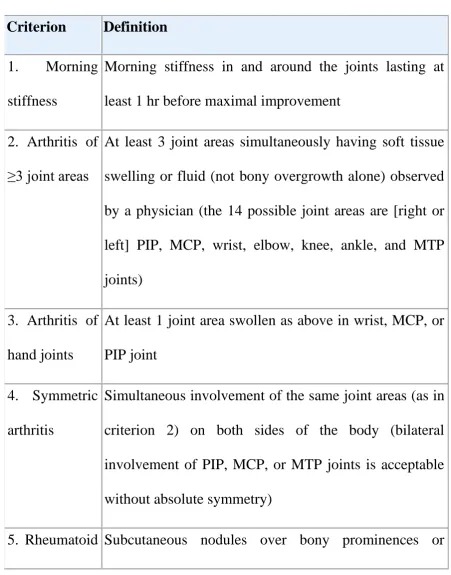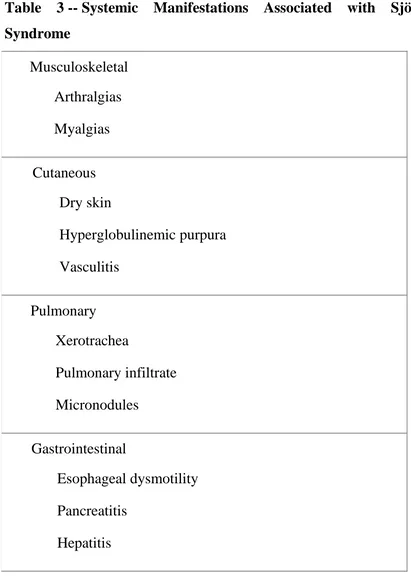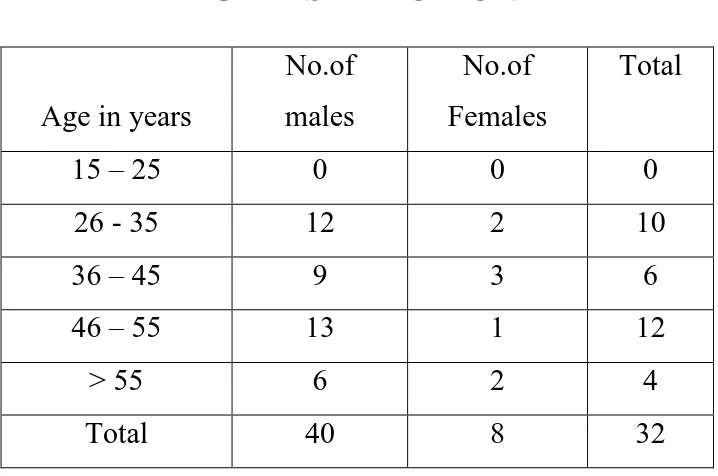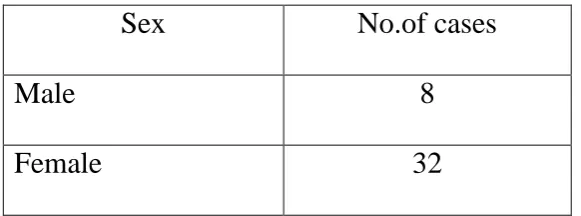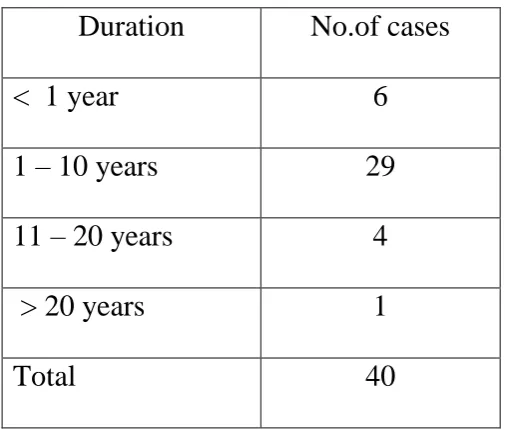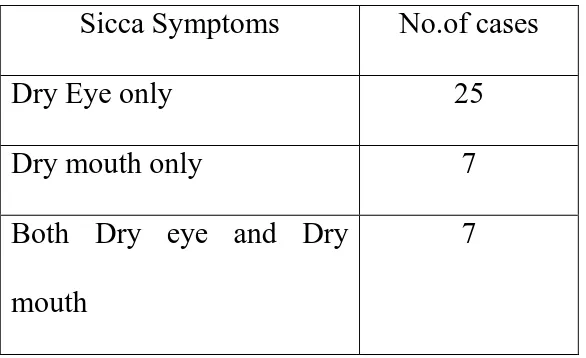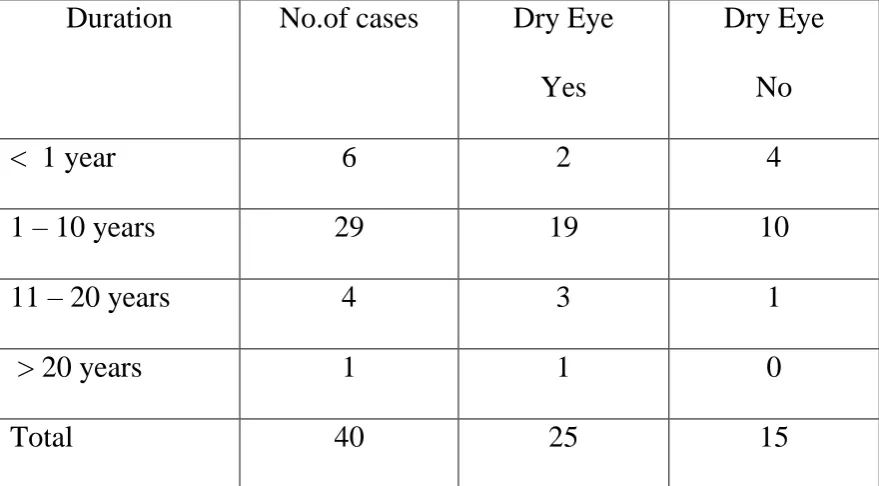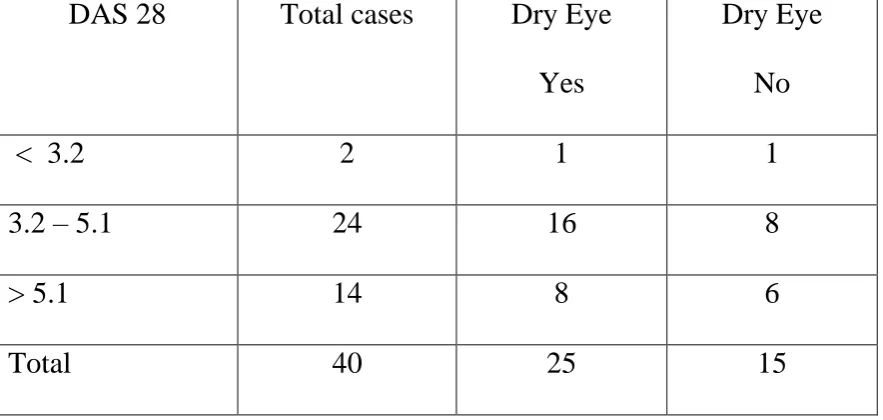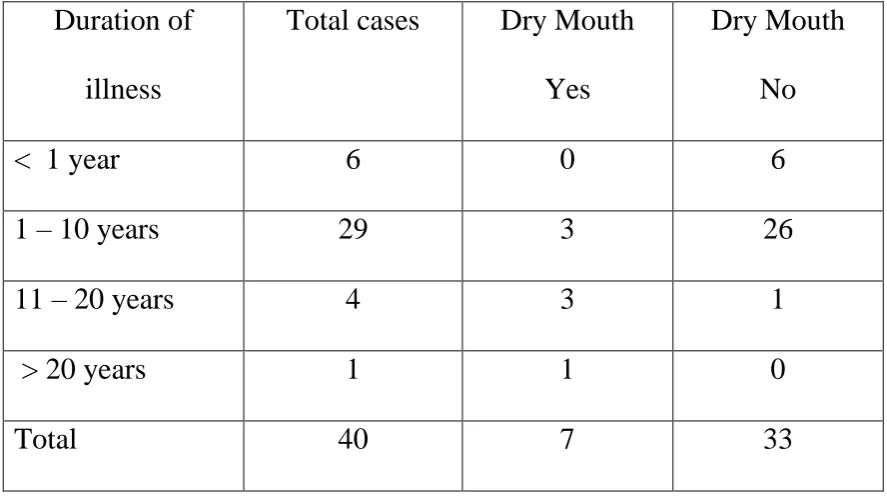A STUDY ON THE PREVALENCE OF SICCA SYNDROME IN PATIENTS WITH RHEUMATOID ARTHRITIS
DISSERTATION SUBMITTED FOR
M.D GENERAL MEDICINE
BRANCH – I
APRIL 2012
THE TAMILNADU
DR.M.G.R. MEDICAL UNIVERSITY
CERTIFICATE
This is to certify that this dissertation titled “A STUDY ON THE
PREVALENCE OF SICCA SYNDROME IN PATIENTS WITH
RHEUMATOID ARTHRITIS” submitted by Dr. AMRITA
RAMASWAMI to the faculty of General Medicine, The Tamil Nadu Dr. M.G.R. Medical University, Chennai in partial fulfillment of the
requirement for the award of MD degree Branch I General Medicine, is
a bonafide research work carried out by her under our direct supervision and guidance.
DR. R . BALAJINATHAN, M.D DR.MOSES.K. DANIEL, M.D.
Professor of Medicine, Professor and Head, Chief, IV Medical Unit, Department of Medicine, Department of Medicine, Madurai Medical College, Madurai Medical College, Madurai.
DECLARATION
I, Dr. AMRITA RAMASWAMI solemnly declare that the
dissertation titled “A STUDY ON THE PREVALENCE OF SICCA
SYNDROME IN PATIENTS WITH RHEUMATOID ARTHRITIS”
has been prepared by me.
This is submitted to The Tamil Nadu Dr. M.G.R. Medical
University, Chennai, in partial fulfillment of the rules and regulations for
the award of MD degree (Branch I) General Medicine.
Place: Madurai
ACKNOWLEDGEMENT
At the outset, I wish to thank our DEAN for permitting me to use
the facilities of Madurai Medical College and Government Rajaji Hospital to conduct this study.
My beloved Head of the Department of Medicine, PROF MOSES
.K. DANIEL, M.D. has always guided me, by example and valuable words of advice and has always given me his moral support and encouragement throughout the conduct of the study and also during my post graduate course. I owe my sincere thanks to him.
I also owe my sincere thanks to my unit chief and my guide
PROF. R.BALAJINATHAN, M.D., for his guidance and advice throughout the study.
Knowledge and kindness abounds my beloved teachers
Dr.S.Vadivelmurugan M.D., Dr. V.T.Premkumar M.D.,Dr Natarajan
M.D ,. Dr Bhagya lakshmi M.D,. Dr Sangumani . J M.D., I owe them a lot and sincerely thank them.
I offer my sincere thanks to Dr. Arul Raja Murugan M.D.,
I offer my heartfelt thanks to my Assistant Professors
Dr.V.N. Alaga Venkatesan M.D., Dr.G. Gurunamasivayam M.D., for
their constant encouragement, timely help and critical suggestions
throughout the study and also for making my stay in the unit both
informative and pleasurable.
My family and friends have stood by me during my times of need. Their help and support have been invaluable to the study.
My patients, who form the most integral part of the work, were always kind and cooperative. I cannot but pray for their speedy recovery and place this study as a tribute to them and to the numerous others likely affected.
Above all I thank the Lord Almighty for His kindness and
benevolence.
CONTENTS
S NO. TOPIC PAGE NO
1. INTRODUCTION 1
2. REVIEW OF LITERATURE 4
3. AIMS AND OBJECTIVES 30
4. MATERIALS AND METHODS 31
5. RESULTS AND ANALYSIS 37
6. DISCUSSION 46
7. CONCLUSION 50
8. SUMMARY 52
9. APPENDIX
INTRODUCTION
Rheumatoid arthritis (RA) is the most common inflammatory arthritis, affecting 0.5% to 1% of the general population worldwide. Although the prevalence is constant across the globe, regardless of geographic location and race, there are some exceptions. In China, the occurrence of RA is lower (about 0.3%), whereas it is substantially higher in other populations, such as the Pima Indians in North America (about 5%). Because of its prevalence and the ready accessibility of joint samples for laboratory investigation, RA has served as a useful model for
the study of many inflammatory and immune-mediated diseases1. As
such, the information gleaned from these studies has provided new and unique insights into the mechanisms of normal immunity.
On occasion, extra-articular manifestations may be the major evidence of disease activity and source of morbidity and require
management per se2.Although the frequency of patients with severe
extra-articular manifestations appears to be declining, these patients have an increased mortality compared to other persons with RA or age- matched normal controls.
Some of the notable extraarticular manifestations are:
1. Rheumatoid vasculitis
2. Pleuropulmonary manifestations
3. Cardiovascular disease
4. Neurologic manifestations
5. Eye involvement in the form of episcleritis and scleritis
6. Sjogren‟s syndrome
7. Felty‟s syndrome
8. Osteoporosis
9. Development of Lymphomas
From 15 – 20% of patients with RA may develop Sjogren‟s syndrome
REVIEW OF LITERATURE
RHEUMATOID ARTHRITIS:
INTRODUCTION:
Rheumatoid arthritis is a symmetric inflammatory arthritis that mainly affects the small joints of the hands and feet. Larger joints can be involved, usually in a symmetric fashion.
Cartilage destruction and bone erosions are common, especially in rheumatoid factor–positive or anticitrullinated protein antibody–positive patients.
Uncontrolled synovitis can lead to severe deformities, loss of function, and increased mortality.
Early aggressive therapy seems to improve long-term outcomes in rheumatoid arthritis.
Systemic manifestations include pulmonary disease, vasculitis, nodules, and eye disease.
EPIDEMIOLOGY AND BURDEN OF THE DISEASE
incidence in women twice that in men. This number was based on many studies of population samples that varied among the surveys from 0.3% to
1.5% 3-5. This figure of 1% prevalence of RA in most populations may be
changing, however, as incidence rates in different decades are studied.
CLINICAL SYNDROMES OF EARLY RHEUMATOID ARTHRITIS: There are distinctive patterns of onset of rheumatoid arthritis. They are
1. Insidious onset
2. Acute or intermediate onset
Insidious Onset
RA has an insidious, slow onset over weeks to months in 55% to
65% of cases6. The initial symptoms may be systemic or articular. In
some individuals, fatigue, malaise, swollen hands, and diffuse musculoskeletal pain may be the first nonspecific complaints, with joints becoming involved later.
lymphatics and venules and returned to the circulation by motion accompanying the use of muscles and joints. To be specific for joint inflammation, morning stiffness (e.g., “difficulty moving around”) should persist for at least 30 to 45 minutes before disappearing. A similar “gel”
phenomenon can occur if a patient is inactive for a period during the day.
Acute or intermediate onset:
Of patients, 8% to 15% have an acute onset of symptoms that peak within a few days. Rarely, a patient can pinpoint the onset of symptoms to a specific time or activity.
SIGNS AND SYMPTOMS OF THE DISEASE:
Articular Involvement
The joints most commonly involved first in RA are the metacarpophalangeal (MCP) joints, proximal interphalangeal (PIP) joints,
metatarsophalangeal joints, and wrists ( Table 1 )7 . Larger joints
Table -1 -- Distribution of Joints Involved in Attacks Based on a Cumulative Experience with 227 Patients1
Joint Involvement % Patients (Mean) % Patients (Range)
MCP, PIP 91 74-100
Wrists 78 54-82
Knees 64 41-94
Shoulders 65 33-75
Ankles 50 10-67
Feet 43 15-73
Elbows 38 13-60
Hips 17 0-40
Temporomandibular 8 0-28
Spine 4 0-11
Sternoclavicular 2 0-6
Pain, swelling and tenderness may initially be poorly localized to the joints. Pain in affected joints, aggravated by movements is the most common manifestation of rheumatoid arthritis. Morning stiffness of more than 1 hour duration is an almost invariable feature of inflammatory arthritis.
With persistent inflammation, a variety of characteristic joint changes develop. These can be attributed to a number of pathologic events, including laxity of supporting soft tissue structures; damage or weakening of ligaments , tendons and the joint capsule; cartilage degradation: muscle imbalance; and unopposed physical forces associated with the use of affected joints. Characteristic changes of the hand include (1) radial deviation of the wrist with ulnar deviation of the digits (“Z”
deformity);(2)Hyperextension of the proximal interphalangeal joints with compensatory flexion of the distal interphalangeal joints.(swan-neck deformity);(3)flexion contracture of the proximal interphalangeal joint and extension of the distal interphalangeal joints (boutonniere deformity)
DEFORMITIES OF THE HAND AND FINGERS IN
Extra-articular Complications of Rheumatoid Arthritis
Generally, the number and severity of extra-articular features vary with the duration and severity of the disease. Several of these features
may be related to extra-articular foci of an immune response8. These
patients with systemic immune responses have true rheumatoid disease, not just RA. Other unusual proteins and protein complexes in the circulation of patients with active rheumatoid disease include antiphospholipid antibodies, circulating immune complexes, and cryoglobulins. Extra-articular manifestations of RA are associated with
excess mortality.9
SKELETON
The skeleton has two anatomically and functionally separate components, cortical and trabecular bone, which respond differently to systemic and local diseases and to drugs. RA can be associated with generalized osteopenia and osteoporosis owing to the effects of drugs
(especially corticosteroids). The risk of hip fracture and vertebral
MUSCLE
Clinical weakness is common in RA, but is it caused by muscle involvement in the rheumatoid inflammation, or is it a reflex weakness response to pain? Most rheumatoid patients have muscle weakness, but few have muscle tenderness or elevated muscle enzymes in the blood.
More recent studies have pointed to at least five different types of muscle disease in RA, although clinically relevant active myositis is
uncommon10:
1. Diminution of muscle bulk with atrophy of type II fibers
2. Peripheral neuromyopathy, usually due to a mononeuritis
multiplex
3. Steroid myopathy
4. Active myositis and muscle necrosis with foci of endomysial
mononuclear cell infiltration
5. Chronic myopathy resembling a dystrophic process, probably the
SKIN
The most frequently recognized skin lesion in RA is the rheumatoid nodule, but there are several other manifestations as well. “Senile”
purpura resulting from skin atrophy and capillary fragility is especially common in patients treated with glucocorticoids. Palmar erythema is common, but Raynaud's syndrome is rare.
EYE
Virtually all ocular manifestations of RA can be considered complications of the disease. Keratoconjunctivitis sicca is a component of Sjögren's syndrome. More directly related to the rheumatoid process and seen in the synovium and within rheumatoid nodules are scleritis and episcleritis. The highly differentiated connective tissues in the eye make rheumatoid manifestations particularly interesting and, when they occur in aggressive form, very serious.
In episcleritis, the eye becomes red and, in contrast to conjunctivitis, results in no discharge other than tearing in response to the gritty discomfort. Loss of vision does not occur as a direct result of the episcleritis, but a keratitis or cataract developing secondarily can cause visual loss.
Scleritis causes severe ocular pain and a dark red discoloration. No discharge is present. Depending on the intensity of the process, scleritis can be localized and superficial or generalized, with or without granulomatous resorption of the sclera down to the uveal layer; when this
complication occurs, it is termed scleromalacia perforans.
Patients with RA who have an associated keratoconjunctivitis sicca secondary to Sjögren's syndrome have pruritic and painful eyes, sometimes leading to chronic blepharitis.
INFECTION
infections such as histoplasmosis. Pulmonary infections, skin sepsis, and
pyarthrosis are among the most common infections in RA. 11,12
CANCER
There is an increased risk for malignancy in RA patients, with an increased risk for lymphoma in certain patient subsets. Interstitial fibrosis may be a risk factor for lung carcinoma, particularly of the
bronchoalveolar variety.13 One exception is cancer of the gastrointestinal
tract, for which there seems to be a reduced risk for RA patients.14 It is
possible that nonsteroidal anti-inflammatory drugs (NSAIDs) lower the risk of this form of cancer, as supported by evidence that these drugs can diminish the occurrence and numbers of colonic polyps.
RA patients are at a two to three times higher risk of Hodgkin's disease, non-Hodgkin's lymphoma, and leukemia than the normal population; this is independent of immunosuppressive therapy.
HEMATOLOGIC ABNORMALITIES
others. A useful guide is that three quarters of rheumatoid patients with anemia have the anemia of chronic disease, whereas one quarter respond to iron therapy. Patients in both groups may have superimposed vitamin
B12 or folate deficiencies.
RENAL DISEASE
The kidney is rarely involved directly in RA, but often is compromised indirectly by therapy. Amyloidosis is an unusual complication of chronic RA. AA amyloidosis, along with vasculitis and sepsis, is one of the most important life-threatening complications of RA.
PULMONARY DISEASE
There are at least six forms of lung disease in RA, as follows:
• Pleural disease
• Interstitial fibrosis
• Nodular lung disease
• Bronchiolitis obliterans with organizing pneumonia
CARDIAC COMPLICATIONS
Cardiac disease in RA can take many forms. It has become apparent that the increased risk of premature death in RA is due largely to an increased incidence of cardiovascular disease, primarily myocardial infarction and congestive heart failure. Advances in echocardiography have made the diagnosis of pericarditis and endocardial inflammation easier and more specific. Myocardial biopsy through vascular catheters has facilitated diagnosis and classification of myocarditis.
DIAGNOSIS
Table 2 -- 1988 Revised American Rheumatism Association Criteria for Classification of Rheumatoid Arthritis1
Criterion Definition
1. Morning
stiffness
Morning stiffness in and around the joints lasting at least 1 hr before maximal improvement
2. Arthritis of ≥3 joint areas
At least 3 joint areas simultaneously having soft tissue swelling or fluid (not bony overgrowth alone) observed by a physician (the 14 possible joint areas are [right or left] PIP, MCP, wrist, elbow, knee, ankle, and MTP joints)
3. Arthritis of hand joints
At least 1 joint area swollen as above in wrist, MCP, or PIP joint
4. Symmetric arthritis
Simultaneous involvement of the same joint areas (as in criterion 2) on both sides of the body (bilateral involvement of PIP, MCP, or MTP joints is acceptable without absolute symmetry)
Criterion Definition
nodules extensor surfaces, or in juxta-articular regions, observed
by a physician
6. Serum
rheumatoid factor
Demonstration of abnormal amounts of serum rheumatoid factor by any method that has been positive
7.
Radiographic changes
Changes typical of RA on posteroanterior hand and wrist radiographs, which must include erosions or unequivocal bony decalcification localized to or most marked adjacent to the involved joints (osteoarthritis changes alone do not qualify)
The history and physical examination are the most sensitive and specific tools for diagnosis of RA. Initial laboratory tests often show the results in the following list .
• Normal white blood cell count and differential
• Mild anemia (hemoglobin 10 g/dL), normochromic and either
normocytic or microcytic
• Normal urinalysis
• ESR 30 mm/hr or greater and C-reactive protein level greater than 0.7
pg/mL
• Normal renal, hepatic, and metabolic tests
• Normal serum uric acid level
• Positive RF test (about 70% to 80% of patients; present in many
normal individuals, patients with other rheumatic diseases, and individuals with chronic infections)
•
Anticitrullinated protein antibody (about 80% to 90% of patients; can be seen in other diseases, including active tuberculosis) (especially useful in early synovitis)
SJOGREN’S SYNDROME :
lacrimal and parotid gland enlargement. Biopsy of these glands revealed
extensive round cell infiltration. In 1953, Morgan and Castleman13 noted
the similarity between the glandular enlargement described by Mikulicz and the keratitis described by Sjogren. Subsequently, these disorders were
considered to be variants of the same process, and the term Sjögren's
syndrome (SS) became more widely used.14
DEFINITIONS :
Primary SS is best defined as dry eyes and dry mouth secondary to autoimmune dysfunction of the exocrine glands. Secondary SS is the same disease in the presence of another autoimmune connective tissue
disorder. Until relatively recently (1980), the terms sicca syndrome and
sicca complex were used interchangeably with SS in the literature, and their routine use in clinical settings persists today.
CAUSE AND PATHOGENESIS
infection, (4) relatively specific autoantibodies are produced, and (5) genes regulating apoptosis influence the chronicity of lymphocytic infiltration and are candidates for therapeutic manipulation.
CLINICAL MANIFESTATIONS
OCULAR
Although the most prominent ocular manifestation of SS is dry eye, patients are often unaware of dryness as a presenting symptom. Instead, they may complain of a foreign body–type sensation manifested by scratchiness, grittiness, or irritation from a “grain of sand.” Other
ORAL
In contrast to dry eye, patients often complain of a dry mouth. Physicians caring for SS patients are accustomed to seeing them carry plastic water bottles because they require a constant supply of moisture to be comfortable. The dry-mouth patient describes a parched feeling in the mouth, often extending to the throat. Eating is often difficult without supplemental liquids. Owing to a reduction in salivary volume and the subsequent loss of the antibacterial properties of saliva, tooth decay is accelerated. In fact, unexplained rampant dental caries may be the first
sign of dry mouth.
OTHER XEROSES
Dry nose is common and may lead to inflammation with subsequent congestion, crusting, and epistaxis. Xerotrachea may result in a chronic dry cough. Dry skin may lead to pruritus and excoriation. Rarely, secondary infection may occur. Vaginal dryness may lead to pruritus, irritation, and dyspareunia. Although the most common cutaneous manifestation of SS is dryness, little is known about the precise cause or whether cutaneous dryness is truly part of the autoimmune exocrinopathy
revealed lymphocytic infiltrates surrounding eccrine glands and ducts in
one patient suffering from severe anhidrosis.16
Table 3 -- Systemic Manifestations Associated with Sjögren's
Syndrome
Musculoskeletal Arthralgias Myalgias
Cutaneous Dry skin
Hyperglobulinemic purpura Vasculitis
Pulmonary Xerotrachea
Pulmonary infiltrate Micronodules
Gastrointestinal
Esophageal dysmotility Pancreatitis
[image:29.595.89.500.164.749.2]
Renal
Renal tubular acidosis Interstitial nephritis
Neurologic
Peripheral neuropathy
Cranial neuropathy (especially fifth cranial nerve) Central nervous system disease
Hematologic Leukopenia Anemia Lymphoma
SECONDARY SJÖGREN'S SYNDROME
as thyroiditis, primary biliary cirrhosis, and MS. Thus, signs of SS should not be overlooked in these contexts.
Clinical SS affects approximately 20% of patients with RA.
Thirty-one percent have positive MSG biopsies.17 SS-A antibodies have been
found in 4% to 23% of RA patients.17,18,19 These patients are more likely
to have severe sicca complaints and positive MSG biopsies.
CLINICAL OUTCOMES
When followed over a 10-year period, approximately one third of
patients with sicca complaints eventually fulfilled the criteria for SS. 20,21
Development of disease and severity of sicca symptoms correlate with the presence of autoantibodies, particularly ANA and SS-A, and the serum IgG level.
DIAGNOSIS AND WORKUP:
The modalities used for the workup of SS are the basis for most of the criteria proposed for the classification of SS. Thus, the evaluation of a patient with suspected SS often requires cooperation among the
is based on the American-European Consensus Group modification of the European Community criteria shown in Table 3.
Table 4 -- AEC Criteria for Sjögren's Syndrome
I. Symptoms of dry eye
Patients must have a positive response to at least one of the following:
Have you had daily, persistent, troublesome dry eyes for more than 3 months?
Do you have a recurrent sensation of sand or gravel in the eyes?
Do you use tear substitutes more than three times a day?
II. Oral symptoms
Patients must have a positive response to at least one of the following:
Have you had a daily feeling of dry mouth for more than 3 months?
glands as an adult?
Do you frequently drink liquids to aid in swallowing dry food?
III. Ocular signs
Patients must have objective evidence of ocular involvement, defined as a positive result from at least one of the following two tests:
Schirmer test performed without anesthesia (5 mm in 5 min)
Rose bengal score or other ocular dye score (4 according to van Bijsterveld's scoring system)
IV. Histopathology
This criterion is met if an expert histopathologist evaluates focal lymphocytic sialadenitis with a focus score of 1 in the patient's minor salivary glands (obtained through normal- appearing mucosa). The focus score is defined as the number of lymphocytic foci adjacent to normal-appearing mucous acini and containing
V. Salivary gland
involvement
Patient must have objective evidence of salivary gland involvement, defined by a positive result for at least one of the following diagnostic tests:
Unstimulated whole salivary flow (1.5 ml in 15 min)
Parotid sialography showing the presence of
diffuse sialectasis (punctate, cavitary, or
destructive pattern) without evidence of
obstruction in the major ducts
Salivary scintigraphy showing delayed uptake, reduced concentration, delayed excretion of tracer, or some combination of these
VI. Autoantibodies
antibodies to Ro (SS-A) or La (SS-B)
Definite Sjögren's syndrome requires the presence of four criteria, one of which must be either a positive biopsy or autoantibodies
Exclusions: prior head and neck radiation, hepatitis C infection, human immunodeficiency virus (HIV) or acquired immunodeficiency syndrome (AIDS), preexisting lymphoma, sarcoidosis, graft-versus-host disease, use of anticholinergic drugs
Serologies, particularly ANA and SS-A and SS-B, correlate with
focus score on biopsy.22 Serum IgG is the most specific predictor of a
positive biopsy but has relatively low sensitivity.23A recent report of 41
patients tested for the presence of anti–SS-A and anti–SS-B and undergoing MSG biopsy showed a fairly high negative predictive value of
anti–SS-A for MSG biopsy.24 Anti–SS-B may be useful in identifying
primary SS among patients presenting with xerostomia, xerophthalmia,
TREATMENT
Therapy for SS has three phases. The first phase consists of external moisture replacement or capture. This approach can be applied to the oral cavity, eyes, nose, skin, and genital tract. The second phase consists of stimulation of endogenous secretions, which has proved effective mainly for xerostomia. This approach is currently under investigation for other xeroses, including the eyes and skin. Finally, patients with systemic
manifestations, such as pulmonary disease, vasculitis and
AIMS AND OBJECTIVES
1. To evaluate the prevalence of the sicca syndrome in patients with
rheumatoid arthritis
2. To estimate the prevalence of sicca symptoms in patients with
rheumatoid arthritis and to look for correlation between the prevalence of sicca symptoms and disease duration and activity
3. To look for the presence of the primary sicca syndrome using
MATERIALS AND METHODS
Ours was a cross sectional study carried out for a period of 1 year. The setting was the Department of Medicine, Government Rajaji Hospital, Madurai. Approval was obtained from the ethical committee headed by the Dean, Govt Rajaji Hospital. Informed written consent was obtained from all patients. The study population consisted of patients attending the outpatient department of rheumatology who were randomly selected. The data obtained was analysed using EPI Info 2002 statistical software.
The study was carried out on 40 patients attending the
Rheumatology out-patient department of Madurai Medical College with an established diagnosis of RA, as defined by the American College of Rheumatology 1987 criteria.
Patients were considered seropositive if the rheumatoid factor
(Latex agglutination test) was positive (>8 IU/L) on atleast one occasion during the course of their disease.
All patients had been treated with nonsteroidal anti-inflammatory
our study were receiving one or more DMARDs including chloroquine, sulfasalazine and methotrexate. Some of them were on low dose steroids (5-15mg/day) depending on severity of symptoms.
INCLUSION CRITERIA :
Patients who satisfied the American College of Rheumatology 1987
criteria.
Age group - 17 to 60 years irrespective of the sex
Any duration of illness
EXCLUSION CRITERIA
Past head and neck irradiation treatment
Hepatitis C infection
AIDS
Pre-existing lymphoma
Use of anti-cholinergic drugs
disease-modifying drugs, corticosteroid use and analgesics was noted. Cigarette consumption was evaluated in pack years (1 pack yr = 20 cigarettes/day for 1 yr).
A detailed clinical examination consisting of examination of the
eyes and oral cavity ,salivary gland swelling, the number of tender and swollen joints and systemic examination was performed. All patients had venous blood taken for full blood count, renal function
tests, erythrocyte sedimentation rate and immunological
investigations including rheumatoid factor (latex agglutination test).
All patients were made to undergo Schirmer‟s I test using test strips
and only those patients who had symptoms and objective evidence of dry eye in the form of wetting of the test strips less than or equal to 5 mm in 5 minutes were subjected to antibody assay.
The activity of the disease was assessed using DAS 28(Disease
activity score).Disease activity score is a composite score using tender and swollen joint count, ESR and patients‟ global assessment
activity using a 100 mm visual analogue scale.
DAS28 = 0.56 √(no.of tender joints) + 0.28 √(no.of swollen joints)
Classification
Mild <3.2
Moderate 3.2-5.1
Severe >5.1 ( Minimum score :0; Maximum score : 9 )
Parameters used in Disease activity score:
(1) Total 28 joint count for tenderness (2) Total 28 joint for swelling
(3) ESR in mm in first hour
(4) Patient assessment of global health using a 100mm visual analogue scale ranging from 0(very good) to 100 (very poor ).
Schirmer’s test and auto antibody profile :
SCHIRMER – I TEST:
The test was performed according to published guidelines. Patients had not used tear substitutes for atleast one hour before examination. Patients dried their eyes carefully with a soft paper tissue ; then the test strips – always starting with the right eye – were placed between the medial and lateral parts of the lower eyelid, and removed after five minutes. Anaesthesia was not used. A positive test for reduced tear production was recorded if the strips were wetted 5 mm or less in one or both eyes, starting from the notch of the test strip corresponding to the inferior lid margin.
AUTO-ANTIBODY PROFILE:
Those patients who had oral and ocular sicca symptoms and a positive Schirmer‟s test in one eye were subjected to a blood profile for
ENA REPORT OF PATIENT SHOWING NEGATIVE RESULTS FOR
ENA REPORT OF PATIENT SHOWING STRONG POSITIVITY FOR
ENA REPORT OF PATIENT SHOWING BORDERLINE
STATISTICS :
Data analysis was done using epidemiological information statistical software. Using the software, the frequencies, mean, standard deviation and „p‟ values were calculated. Chi square test and one way ANOVA were applied to the quantitative variables. „p‟ value < 0.05 was
RESULTS
Baseline demographics and clinical characteristics:
[image:48.595.138.497.419.657.2]The study was conducted from December 2010 to November 2011 recruiting subjects from the rheumatology outpatient clinic of Government Rajaji Hospital, Madurai. A total of 40 RA patients were enrolled during this study period. Women outnumbered men in the study population with 32 women and 8 men. In our study, the age of the participants varied from 17 to 60 years.
Table - 1
AGE DISTRIBUTION:
Age in years
No.of males
No.of Females
Total
15 – 25 0 0 0
26 - 35 12 2 10
36 – 45 9 3 6
46 – 55 13 1 12
> 55 6 2 4
Total 40 8 32
AGE DISTRIBUTION
0
10
6
12
4
0 2 4 6 8 10 12 14
15 – 25 26 - 35 36 – 45 46 – 55 > 55
Table - 2
SEX DISTRIBUTION
Sex No.of cases
Male 8
Female 32
SEX DISTRIBUTION
20%
80%
Table – 3
Duration of Illness
Duration No.of cases
< 1 year 6
1 – 10 years 29
11 – 20 years 4
> 20 years 1
Total 40
6
29
4
1
0 5 10 15 20 25 30
< 1 year 1 – 10 years 11 – 20 years > 20 years DURATION OF ILLNESS
Table - 4
PREVALENCE OF SICCA SYMPTOMS
Sicca Symptoms No.of cases
Dry Eye only 25
Dry mouth only 7
Both Dry eye and Dry mouth
7
25
7 7
0 5 10 15 20 25
Dry Eye only Dry mouth only Both Dry eye and Dry mouth Prevalence of Sicca Symptoms
Table – 5
PREVALENCE OF OBJECTIVE EVIDENCE OF DECREASED
TEAR PRODUCTION (POSITIVE SCHIRMER’S TEST)
Schirmer‟s Test No.of cases Both Eyes
< 5mm
One eye < 5mm
< 5mm 13 (32.5%) 8 5
> 5 mm 27 (67.5%)
Of the 40 patients studied, 13(32.5%) patients had a positive Schirmer‟s test. Of these 8 patients were positive in both eyes and 5 were
Table – 6
CORRELATION BETWEEN DRY EYE AND DISEASE
DURATION:
Duration No.of cases Dry Eye
Yes
Dry Eye No
< 1 year 6 2 4
1 – 10 years 29 19 10
11 – 20 years 4 3 1
> 20 years 1 1 0
Total 40 25 15
CORRELATION BETWEEN DRY EYE AND DISEASE DURATION
2
19
3
1 4
10
1
0 0
2 4 6 8 10 12 14 16 18 20
< 1 year 1 – 10 years 11 – 20 years > 20 years
Table – 7
CORRELATION BETWEEN DRY EYE AND DAS 28
DAS 28 Total cases Dry Eye
Yes
Dry Eye No
< 3.2 2 1 1
3.2 – 5.1 24 16 8
> 5.1 14 8 6
Total 40 25 15
1 1
16
8 8
6
0 2 4 6 8 10 12 14 16
< 3.2 3.2 – 5.1 > 5.1
CORRELATION BETWEEN DRY EYE AND DAS 28:
Table – 8
CORRELATION BETWEEN DRY MOUTH AND DISEASE
DURATION
Duration of illness
Total cases Dry Mouth
Yes
Dry Mouth No
< 1 year 6 0 6
1 – 10 years 29 3 26
11 – 20 years 4 3 1
> 20 years 1 1 0
Total 40 7 33
Table - 9
CORRELATION BETWEEN DRY MOUTH AND DAS 28:
DAS 28 Total cases Dry Mouth
Yes
Dry Mouth No
< 3.2 2 1 1
3.2 – 5.1 24 5 19
> 5.1 14 2 12
Total 40 8 32
There was a positive correlation between disease severity assessed by DAS 28 and the occurrence of dry mouth symptoms with a „p‟ value
of 0.03.
DISCUSSION
The prevalence of Sjogren‟ s syndrome in association with
autoimmune disease is not well established. This results from the lack of uniform criteria for the diagnosis of this syndrome, differences in diagnostic techniques for evaluating keratoconjunctivitis sicca and xerostomia, and the absence of prospective studies on the true prevalence of the syndrome in association with other diseases.
Sjogren‟s syndrome can be diagnosed when any two of the
following three clinical features are present : dry eyes, dry mouth and arthritis. Typical lesions in the eyes and mouth, however, are not always present at the same time nor at the same stage of development ; also, spontaneous clinical remission may occur.
Demographics and clinical characteristics :
Prevalence of sicca symptoms and objective evidence of decreased
tear production:
In our study , 62.5% of the 40 patients responded positively to questions on dry eye symptoms, 17.5% had symptoms of dry mouth, 17.5% had symptoms of both dry eye and dry mouth. In a similar study
done by T Uhlig et al26 , ocular sicca symptoms were reported in 38%,
oral sicca symptoms in 50% and a combination of both in 27 %. Reduced tear production as evidenced by a positive Schirmer‟s test was present in
29%. Of the 40 patients studied, 13 patients had a positive Schirmer‟s test with a prevalence of 32.5% closely paralleling the findings of the above mentioned study. Previous studies examining the sicca symptoms in RA
patients are sparse. Andonopoulos et al27 examined 111 RA patients and
found sicca symptoms from eyes in 38% , from mouth in 6%. In another
minor study28, Schirmer‟s test was reduced in 30% of RA patients
mirroring the findings of our study. Such different results may be partly explained by different approaches in the assessment of sicca symptoms
Correlation of sicca symptoms with disease activity and duration:
symptoms of dry eye and disease activity as assessed by DAS 28. In our study however, a positive correlation was found between symptoms of dry mouth and disease activity whereas no correlation could be made out between dry mouth symptoms and disease duration. These findings are
similar to those of the study conducted by T Uhlig et al26 in which no
correlation could be found between ocular and oral dryness and disease activity and duration.
Prevalence of sicca syndrome in RA patients:
The prevalence of sicca syndrome in our study as evidenced by patients satisfying the revised AEC criteria was 5%. In a study by Fujita
et al29 of 72 Japanese patients, just 10% of them had secondary Sjogren‟s
syndrome. The presence of sicca syndrome in RA has been found to be
higher in other studies. Cimmino et al30 found it in 17.5% of Italian RA
patients and Martinez Castro et al31 in 55% of Spanish RA population.
CONCLUSION
In conclusion, the prevalence of ocular sicca symptoms in RA patients attending the rheumatology outpatient clinic in Government Rajaji hospital was 62.5% and that of oral symptoms alone was 17.5%. A combination of both ocular and oral dryness was present in 17.5%.
There was no significant correlation between disease duration and symptoms of dry eye in our study group. There was no statistically significant correlation between dry eye symptomatology and disease activity. Though no correlation could be found out between disease duration and dry mouth, there was a statistically significant correlation between dry mouth symptoms and disease activity.
The patients who completely satisfied the AEC criteria for the diagnosis of primary sicca syndrome in our study population were 2 in number yielding a prevalence of primary sicca syndrome of 5% .
SUMMARY
The study “ Prevalence of sicca syndrome in patients with rheumatoid arthritis” is a cross- sectional study conducted on patients
visiting the outpatient department of rheumatology, Government Rajaji hospital,Madurai.Forty patients with rheumatoid arthritis fulfilling the American Rheumatologists association criteria(1987) were included in the study.Inclusion and exclusion criteria were strictly followed. Selected patients underwent clinical and laboratory evaluation to assess the severity and activity of disease including Schirmer‟s test for ocular
BIBLIOGRAPHY
1.Kelley‟s Textbook of Rheumatology, Eighth edition , Volume II. 2.Harrison„s Rheumatology , Second edition .
3. Wolfe A.M.: The epidemiology of rheumatoid arthritis: A review, I: Surveys. Bull Rheum Dis 1968; 19:518-523.
4. Engel A., Roberts J., Burch T.A.: Rheumatoid arthritis in adults in the United States, 1960-1962. In Vital and Health Statistics, Series 11, Data from
the National Health Survey, Number 17. Washington, DC, National Center for
Health Statistics, 1966.
5. Mikkelsen W.M., Dodge H.J., Duff I.F., et al: Estimates of the prevalence of rheumatic disease in the population of Tecumseh, Michigan, 1959-1960. J
Chronic Dis 1967; 20:351-369.
6. Fleming A., Crown J.M., Corbett M.: Early rheumatoid disease, I: Onset.
Ann Rheum Dis 1976; 35:357-360.
7. Fleming A., Benn R.T., Corbett M., et al: Early rheumatoid disease, II: Patterns of joint involvement. Ann Rheum Dis 1976; 35:361-364.
8. Halla J.T., Schrohenloher R.E., Koopman W.J.: Local immune responses in certain extra-articular manifestations of rheumatoid arthritis. Ann Rheum Dis 1992; 51:698-701.
9. Turesson C., O'Fallon W.M., Crowson C.S., et al: Occurrence of extraarticular disease manifestations is associated with excess mortality in a community based cohort of patients with rheumatoid arthritis. J
10. Halla J.T., Koopman W.J., Fallahi S., et al: Rheumatoid myositis: Clinical and histologic features and possible pathogenesis. Arthritis
Rheum 1984; 27:737-743.
11. Baum J.: Infection in rheumatoid arthritis. Arthritis Rheum 1971; 14:135-137.
12. Huskisson E.C., Hart F.D.: Severe, unusual and recurrent infections in rheumatoid arthritis. Ann Rheum Dis 1972; 31:118-121.
13.Morgan W.S., Castleman B.: A clinicopathologic study of Mikulicz's disease. Am J Pathol 1953; 29:471.
14.Mason A.M., Gumpel J.M., Golding P.L.: Sjögren's syndrome: A clinical review. Semin Arthritis Rheum 1973; 2:301.
15. Katayama I., Yokozeki H., Nishioka K.: Impaired sweating as an exocrine manifestation in Sjögren's syndrome. Br J Dermatol 1995; 133:716.
16. Mitchell J., Greenspan J., Daniels T., et al: Anhidrosis (hypohidrosis) in Sjögren's syndrome. J Am Acad Dermatol 1987; 16:233.
17. Andonopoulos A.P., Drosos A.A., Skopouli F.N., et al: Secondary Sjögren's syndrome in rheumatoid arthritis. J Rheumatol 1987; 14:1098. 18. Skopouli F.N., Andonopoulos A.P., Moutsopoulos H.M.: Clinical implications of the presence of anti-Ro(SSA) antibodies in patients with rheumatoid arthritis. J Autoimmun 1988; 1:381.
19.. Boire G., Menard H.A., Gendron M., et al: Rheumatoid arthritis: Anti-Ro antibodies define a non-HLA-DR associated clinicoserological cluster. J
20. Pertovaara M., Korpela M., Uusitalo H., et al: Clinical follow-up study of 87 patients with sicca symptoms (dryness of eyes or mouth, or both). Ann
Rheum Dis 1999; 58:423.
21. Kruize A.A., van Bijsterveld O.P., Hene R.J., et al: Long-term course of tear gland function in patients with keratoconjunctivitis sicca and Sjögren's syndrome. Br J Ophthalmol 1997; 81:435.
22. Shah F., Rapini R.P., Arnett F.C., et al: Association of labial salivary gland histopathology with clinical and serologic features of connective tissue diseases. Arthritis Rheum 1990; 33:1682.
23. Brennan M.T., Sankar V., Leakan R.A., et al: Risk factors for positive minor salivary gland biopsy findings in Sjögren's syndrome and dry mouth patients. Arthritis Rheum 2002; 47:189.
24. Kessel A., Toubi E., Rozenbaum M., et al: Sjögren's syndrome in the community: Can serology replace salivary gland biopsy?. Rheumatol Int 2006; 26:337.
25.Vitali C., Monti P., Giuiggioli C., et al: Parotid sialography and lip biopsy in the evaluation of oral component in Sjögren's syndrome. Clin Exp
Rheumatol 1989; 7:131.
26.T Uhlig , T K Kvien, J L Jensen,T Axell: Sicca asymptoms, saliva and tear production, and disease variables in 636 patients with rheumatoid arthritis. Ann Rheum Dis 1999;58:415-422
28.Castro EM, Marques AO, Llorach MB,Abello JC,Valeri EC, Valdor SJ. Rheumatoid arthritis and Sjogren‟s syndrome, with special reference to the duration of rheumatoid arthritis. Med Clin(Barc) 1990;94: 655-9
29.Fujita N,Igarashi T,Kurai T,Sakane N,Takahasi H.Correlation between dry eye and rheumatoid arthritis activity.Ophthalmology – 2005;140:808-13
30.Cimmino MA, Salvarani C, Macchioni P, Montecucco C, Fossaluzza V, Mascia MT.Extra- articular manifestations in 587 Italian patients with rheumatoid arthritis.Rheumatol Int. 2000;19:213-7
PROFORMA
A STUDY ON THE PREVALENCE OF SICCA SYNDROME IN PATIENTS WITH RHEUMATOID ARTHRITIS
Name :
Age : Sex : Address : Ph :
CLINICAL FEATURES Duration of illness – Disease Activity – Sicca symptoms – Ocular symptoms –
1. Have you had daily, persistent, troublesome dry eyes for more than 3 months? 2. Do you have a recurrent sensation of sand or gravel in the eyes?
3. Do you use tear substitutes more than three times a day? Oral symptoms –
1. Have you had a daily feeling of dry mouth for more than 3 months? 2. Have you had recurrent or persistently swollen salivary glands as an adult? 3. Do you frequently drink liquids to aid in swallowing dry foods?
Negative history - History of head and neck irradiation, usage of anticholinergics/TCA, Jaundice EXAMINATION –
Oral cavity examination –
Schirmer’s test - <5mm >5mm Examination of salivary glands –
Lymphadenopathy –
Examination of joints for swelling and tenderness LABORATORY INVESTIGATIONS –
Renal function test Liver function test Hb
TC ESR Anti HCV HIV
Rheumatoid factor ENA profile –
No
N
ame
Age Sex
D OI EM S H ype rt en si o n D ia b et es D AS 28 s/o d ry e ye s/o d ry m o u th B loo d u re a
Creat RB
S
Hb
1 Thirumalaiselvi 40
f 3 months 1/2 hr No
No 5.06
No
No 22.3 mg% 0.78 mg% 110 mg% 9.3
2 Kaleeswari 28 f 2 years No No
No 5.54
Yes
No 24.6 mg% 0.92 mg% 115 mg% 9.6
3 Krishnaveni 58 f 2 years No
Yes
No 4.89
Yes
Yes 26.2 mg% 0.89 mg% 77 mg% 6.9
4 Arumugam 32
m 1 year No
No
No 4.12
No
No 18.6 mg% 0.63 mg% 160 mg% 11.9
5 Surendiran 58
m 3 years No
No
No 3.95
No
No 19.0 mg% 1.2 mg% 86 mg% 12
6 Murugan 33 m 2 years 1/4 hr
No
No 4.43
Yes
No 27 mg% 0.8 mg% 68 mg% 11
7 Pushpam 56 f 1 year 1/2 hr
Yes
No 4.99
Yes
Yes 18 mg% 0.8 mg% 90 mg% 10
8 Ramalakshmi 32 f 4 years 1/4 hr
No
No 3.38
Yes
Yes 24 mg% 0.89 mg% 157 mg% 11.7
9 Dhanalakshmi 52 f 15 years 1/4 hr
No
No 5.96
Yes
Yes 24.2 mg% 0.88 mg% 113 mg% 10.4
10 Thilagam 53 f 2 years 1/4 hr
Yes
No 6.78
No
No 24.3 mg% 0.81 mg% 105 mg% 11.6
11 Anarkali 58 f 10 years 1/4 hr
No
No 6.46
No
No 24 mg% 0.89 mg% 187 mg% 9.4
12 Arokiammal 54 f 17 years 1/4 hr
No
No 4.47
No
13 Manimala 48 f 3 years 1/4 hr
No
No 5.28
No
No 21.1 mg% 0.7 mg % 114 mg% 12.7
14 Ajanta 49 f 1 year 1/4 hr
Yes No 2.94
No
No 20 mg% 1.0 mg% 102 mg% 11.8
15 Manimegalai 50 f 1 year 1/4 hr
No
No 4.9
No
No 26.4 mg% 0.82 mg% 122 mg% 10.2
16 Amudha 36 f 5 years 1 hr
No
No 4.09
No
No 26.7 mg% 0.92 mg% 114 mg% 10.2
17 Gunasekaran 58
m 5 years 1 hr
No
No 5.35
No
No 27.2 mg% 0.96 mg% 148 mg% 9.2
18 Lalitha Ganesan 39 f 10 years 1/2 hr
No
No 6.18
No
No 16 mg% 0.71 mg% 77 mg% 11
19 Vasantha 50 f 2 years 1/4 hr
Yes
No 4.87
Yes No 24 mg% 0.6 mg% 117 mg% 12
20 Chandra 47 f 20 years 1/2 hr
No
No 3.28
Yes
Yes 29 mg% 0.8 mg% 107 mg% 10.6
21 Veerammal 47 f 3 years 1/2 hr
No
No 5.87
No
No 29.7 mg% 0.7 mg% 135 mg% 9.8
22 Chellammal 50 f 2 years No
No
No 4.68
Yes
No 20.3 mg% 0.7 mg% 114 mg% 12
23 Rajeswari 25 f
2
months 1/4 hr
No
No 4.78
No
No 19.8 mg% 0.6 mg% 105 mg% 11
24 Jasmine 31
f 1 year No
No
No 5.09
Yes
No 23 mg% 0.8 mg% 95 mg % 11.1
25 Jothi 45
m
2
months No
No
No 4.11
No
No 24.5 mg% 0.76 mg% 108 mg% 10
26 Saraswathy 38 f 1 year 1/4 hr
No
No 2.89
No
No 29 mg% 0.7 mg% 99 mg% 12
27 Gomathy 54 f 10 years 1 hr
No
No 6.7
No
No 27.3 mg% 0.86 mg% 132 mg% 10.2
28 Bakeeral Begum 56 f 22 years 1/2 hr
Yes
Yes 4.3
Yes
29
Uma
Maheswari 36 f
5
months No
No
No 5.15
No
No 14.42 mg% 1.04 mg% 72 mg% 12
30 Vazhivittan 47
m 8 months No
No
No 4.51
Yes
No 26.2 mg% 0.86 mg% 134 mg% 9.7
31 Fathima Beevi 45 f 12 years No No
Yes 5.13
Yes
Yes 27.3 mg% 0.92 mg% 124 mg% 10.7
32 Jareena Begum 48 f 2.5 years No No
Yes 5.8
Yes
No 24 mg% 0.9 mg% 130 mg% 9.2
33 Mariappan 38 m 7 years 1/4 hr No
No 4.26
No
No 25 mg% 1.0 mg% 123 mg% 9.8
34 Latha 34 f 3 years 1/4 hr No
No 5.48
No
No 30 mg% 0.6 mg% 118 mg% 10.7
35 Kaliammal 27 f 2 years 1/2 hr No
No 4.21
Yes
No 29 mg% 0.8 mg% 143 mg% 12
36 Chandran 43
m 10 years No
No
No 5.07
No No 34 mg% 1.2 mg% 118 mg% 10.8
37 Durga 27 f 8 months 1/2 hr
No
No 4.56
Yes
No 32 mg% 0.9 mg% 104 mg% 12.4
38 Chitra 32
f 5 years 1/4 hr
No
No 4.37
Yes
No 24 mg% 0.6 mg% 97 mg% 9.4
39 Chinnammal 28
f 3.5 years 1 hr
No
No 3.84
No
No 28 mg% 0.6 mg% 130 mg% 11.2
40 Pothumponnu 35
f 2 years 1/2 hr
No
No 5.85
Yes
TC ESR ST R ST L SS -A SS -B Ro -52
8000 62
24 mm
20
mm - - -
6400 50
< 5mm
<5
mm Positive Negative Positive
8300 60 9 mm
12
mm - - -
8500 15
< 5
mm 7 mm Negative Negative Negative
9500 8 15 mm
15
mm - - -
11400 15 25 mm
20
mm - - - 9800 20 < 5mm < 5 mm Negative Negative Negative
14500 10 15 mm 20 mm - - -
8500 55 < 5 mm < 5 mm Negative Negative Negative
9800 20 21 mm 17 mm - - -
11800 70
< 5
mm 7 mm Negative Negative Negative
8700 10 15 mm 15 mm - - -
8900 8 < 5 mm < 5 mm Negative Negative Negative
6700 8 10 mm 12 mm - - -
9200 55 20 mm 15 mm - - -
8800 55
< 5
mm < 5 mm Negative Negative Negative
7200 55 30 mm 28 mm - - -
5600 30 < 5 mm < 5 mm Negative Negative Negative
4700 20
10
mm 15 mm - - -
7000 45 20 mm 25 mm - - -
8300 25 < 5 mm 9 mm Negative Negative Negative
15700 47 18 mm 25 mm - - -
6700 39 12 mm 12 mm - - -
9500 60 14 mm 12 mm - - -
7000 12 15 mm 12 mm - - -
10000 47 14 mm 12 mm - - -
14400 25 <5 mm < 5 mm Negative Negative Negative
7400 30 15 mm 20 mm - - -
6700 40 10 mm 12 mm - - -
6900 75 < 5 mm < 5 mm Negative Negative Positive
11100 40 10 mm 8 mm - - -
9800 26 < 5 mm 8 mm Negative Negative Negative
10300 38 8 mm 10 mm - - -
12000 30 20 mm 16 mm - - -
8000 35 10 mm 12 mm - - -
6700 27 15 mm 14 mm - - -
4500 30
< 5
mm 10 mm Negative Negative Negative
8600 15 14 mm 12 mm - - -
13000 45
18
